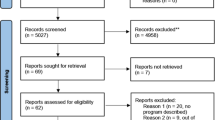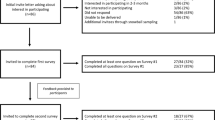Abstract
Many concerned scientists believe that developments in the medical application of genomics will widen the gap between the developed and the developing world. We argue that most developing countries now urgently need to incorporate genetic approaches (including DNA diagnosis) into their health services, and that many are able to do so. DNA diagnosis is relatively inexpensive, helps to develop skills in molecular biology and provides a basis for developing national expertise in genomics.
This is a preview of subscription content, access via your institution
Access options
Subscribe to this journal
Receive 12 print issues and online access
$189.00 per year
only $15.75 per issue
Buy this article
- Purchase on Springer Link
- Instant access to full article PDF
Prices may be subject to local taxes which are calculated during checkout



Similar content being viewed by others
References
Advisory Committee on Health Research. Genomics and World Health (World Health Organization, Geneva, 2002).
Bloom, B. R. & Trach, D. D. Genetics and developing countries. BMJ 322, 1006–1007 (2001).
The World Bank. World Development Indicators 1999 [online] (cited 26/11/02) <http://www.worldbank.org> (1999).
Rimoin, D. L., Connor, J. M., Peyeritz, R. E. & Korf, B. R. (eds) Principles and Practice of Medical Genetics, 4th edn (Churchill Livingstone, London, 2002).
Berwick, D. “We all have AIDS”: case for reducing the cost of HIV drugs to zero. BMJ 324, 214–216 (2002).
Childs, B. & Scriver, C. R. Age at onset and causes of disease. Perspect. Biol. Med. 29, 437–460 (1985).
Czeizel, A. & Sankaranarayanan, K. The load of genetic and partly genetic disorders in man. I. Congenital anomalies: estimates of detriment in terms of years of life lost and years of impaired life. Mutat. Res. 128, 73–103 (1984).
Baird, P. A., Anderson, T. W., Newcombe, H. B. & Lowry, R. B. Genetic disorders in children and young adults: a population study. Am. J. Hum. Genet. 42, 677–693 (1988).
WHO Advisory Group on Hereditary Diseases. Community Approaches to the Control of Hereditary Diseases [online] <http://whqlibdoc.who.int/hq/1985-86/HDP_WG_85.10.pdf> (1985).
Alwan, A. A. & Modell, B. Community Control of Genetic and Congenital Disorders. EMRO Technical Publications Series 24 (World Health Organization, Regional Office for the Eastern Mediterranean, Cairo, 1997).
World Health Organization. Guidelines for Control of Haemoglobin Disorders WHO/HDP/HB/GL/94.1 (WHO, Geneva, 1994).
World Health Organization. Glucose-6-phosphate dehydrogenase deficiency. Report of a WHO Working Group. Document HDP/WP/G6PD/85.9 (WHO, Geneva, 1985).
Bittles, A. H. Consanguineous Marriage: Current Global Incidence and its Relevance to Demographic Research (Population Studies Center, University of Michigan, 1990).
United Nations. Demographic Yearbook Series (United Nations/Nations Unies, New York, 1981 and 1999 (figure 3), and 1999 (calculations in figure 1 and table 1).
World Health Organization. Primary Health Care Approaches for the Prevention and Control of Congenital and Genetic Disorders WHO Meeting Report, Cairo, Egypt, 6–8 December 1999, WHO/HGN/WG/00.1 (WHO, Geneva, 2000).
Christianson, A. L. Down syndrome in sub Saharan Africa. J. Med. Genet. 33, 89–92 (1996).
Czeizel, A., Intody, Z. & Modell, B. What proportion of congenital anomalies can be prevented? BMJ 306, 499–502 (1993).
World Health Organization. The Global Strategy for the Prevention and Control of Noncommunicable Diseases — Report of the Director General (Report from the 53rd World Health Assembly, Geneva, 2000).
Alwan, A., Maclean, D. & Mandil, A. Assessment of National Capacity for Noncommunicable Disease Prevention and Control: The Report of a Global Survey (World Health Organization, Geneva, 2001).
Department of Health. Report on Health and Social Subjects. 50. Folic Acid and the Prevention of Disease: Report of Committee on Medical Aspects of Food and Nutrition Policy (DoH, London, UK, 2000).
Czeizel, A. E. Reduction of urinary tract and cardiovascular defects by periconceptional multivitamin supplementation. Am. J. Med. Genet. 62, 179–183 (1996).
Barker, D. J. P. (ed.) Fetal and Infant Origins of Adult Disease (British Medical Journal, London, 1993)
World Health Organization. Reducing Risks, Promoting Healthy Life (WHO, Geneva, 2002).
Chitty, L. in Fetal Medicine. Basic Science and Clinical Practice (eds Rodeck, C. H. & Whittle, M. J.) 389–408 (Churchill Livingstone, London, 1999).
Murray, J., Cuckle, H., Taylor, G., Littlewood, J. & Hewison, J. Screening for Cystic Fibrosis. Health Technology Assessment Vol. 3, No. 8 [online] <http://www.hta.nhsweb.nhs.uk> (1999).
Seymour, C. A. et al. Newborn Screening for Inborn Errors of Metabolism: A Systematic Review. Health Technology Assessment Vol. 1, No. 11 [online] <http://www.hta.nhsweb.nhs.uk> (1997).
Declaration of Alma-Ata. International Conference on Primary Health Care, Alma-Ata, USSR, 6–12 September 1978 [online] <http://www.who.int/hpr/archive/docs/almaata.html> (1978).
Petrou, M. & Modell, B. Prenatal screening for haemoglobin disorders. Prenat. Diagn. 15, 1275–1295 (1995).
Modell, B., Darlison, M., Khan, M. & Harris, R. Role of genetic diagnosis registers in ongoing consultation with the community. Commun. Genet. 3, 144–147 (2001).
World Health Organization. Health InterNetwork Access to Research Initiative (HINARI) [online] <http://www.healthinternetwork.org> (1986).
SciDevNet. [online] <http://www.scidev.net> (2002).
Modell, B. & Darlison, M. New developments in genetics for the new millennium: the concept of clinical bioinformatics. Commun. Genet. 3, 184–189 (2001).
Orphanet. [online] <http://orphanet.infobiogen.fr> (2002).
World Health Organization. Services for the Prevention and Management of Genetic Disorders and Birth Defects in Developing Countries (WHO, Geneva, 1999).
Penchaszadeh, V. in Genetics and Public Health in the 21st Century (eds Khoury, M. J., Burke, W. & Thomson, E. J.) 301–327 (Oxford Univ. Press, New York, 2000).
Ahmed, S., Saleem, M., Modell, B. & Petrou, M. Extended family studies: a cost effective approach for genetic counseling for hemoglobin disorders in Pakistan. N. Engl. J. Med. 347, 1162–1168 (1991).
Bundey, S. & Aslam, H. A five-year prospective study of the health of children in different ethnic groups, with particular reference to the effect of inbreeding. Eur. J. Hum. Genet. 1, 206–219 (1993).
Modell, B. & Darr, A. Genetic counselling and customary consanguineous marriage. Nature Rev. Genet. 3, 225–229 (2002).
Modell, B., Kuliev, A. M. & Wagner, M. Community Genetics Services in Europe European Series No. 38 (WHO Regional Publications, Copenhagen, 1991).
Titmuss, R. M. The Gift Relationship; From Human Blood to Social Policy Updated edn (eds Oakley, A. & Ashton, J.) (London School of Economics and Political Science, London, 1997).
Angastiniotis, M. A., Kyriakidou, S. & Hadjiminas, M. How thalassaemia was controlled in Cyprus. World Health Forum 7, 291–297 (1986).
Kuliev, A. M. Thalassaemia can be prevented. World Health Forum 7, 286–290 (1986).
World Health Organization. Haemoglobin Disorders as a Model for Integrating Genetics into Health Care, Report of a WHO Meeting, Athens, Greece, 18 October 2001, Annex 4.2, The Tunisian Experience (WHO, Geneva, 2002).
Zeuner, D. et al. Antenatal and Neonatal Haemoglobinopathy Screening in the UK: Review and Economic Analysis NHS R&D HTA Programme [online] <http://www.hta.nhsweb.nhs.uk> (1999).
Luzzatto, L. & Mehta, A. in The Metabolic Basis of Inherited Disease 7th edn Vol. 3 (eds Scriver, C. R., Beaudet, A. L., Sly, W. S. & Valle, D.) 3367–3398 (McGraw–Hill, Inc., New York, 1995).
Karnon, J. et al. Lifetime treatment costs of β-thalassaemia major. Clin. Lab. Haematol. 21, 377–385 (1999).
Liu, J. Studies of β-thalassemia mutations and prenatal diagnosis in Guangxi, Guangdong and Sichuan Provinces of South China. Zhongguo-Yi-Xue-Ke-Xue-Yuan-Xue-Bao 12, 90–95 (1990) (in Chinese).
Chan, T. K. et al. Prenatal diagnosis of α- and β-thalassemias: experience in Hong Kong. Hemoglobin 12, 787–794 (1988).
Thakur-Mahadik, C. et al. Prenatal diagnosis of β-thalassaemia and other haemoglobinopathies in India. Prenat. Diagn. 20, 194–201 (2000).
Setianingsih, I. et al. Phenotypic variability of Filipino β(0)-thalassemia/HbE patients in Indonesia. Am. J. Hematol. 62, 7–12 (1999).
George, E. et al. Spectrum of β-thalassaemia mutations in transfusion dependent thalassaemia patients: practical implications in prenatal diagnosis. Med. J. Malaysia 48, 325–329 (1993).
Chern, S. R. & Chen, C. P. Molecular prenatal diagnosis of thalassemia in Taiwan. Int. J. Gynaecol. Obstet. 69, 103–106 (2000).
Fucharoen, S. Prenatal diagnosis of thalassemia and hemoglobinopathies in Thailand: experience from 100 pregnancies. SE Asian J. Trop. Med. Public Health 22, 16–29 (1991).
Altay, C., Yilgor, E., Beksac, S. & Gurgey, A. Premarital screening of hemoglobinopathies: a pilot study in Turkey. Hum. Hered. 46, 112–114 (1996).
Acknowledgements
B.M. is a retired Wellcome Principal Research Fellow.
Author information
Authors and Affiliations
Corresponding author
Related links
Related links
DATABASES
OMIM
FURTHER INFORMATION
Accessible Publishing of Genetic Information (APoGI) on haemoglobin disorders
Epidemiological information on consanguineous marriage
Information on rare diseases (including many inherited disorders) in six languages
SciDevNet (news, views, and information about science and development)
The Health InterNetwork Access to Research Initiative (HINARI)
Rights and permissions
About this article
Cite this article
Alwan, A., Modell, B. Recommendations for introducing genetics services in developing countries. Nat Rev Genet 4, 61–68 (2003). https://doi.org/10.1038/nrg978
Issue Date:
DOI: https://doi.org/10.1038/nrg978
This article is cited by
-
Psychosocial impacts of caring for a child with a genetic disorder in Accra, Ghana
Journal of Community Genetics (2023)
-
Diagnostic yield of pediatric and prenatal exome sequencing in a diverse population
npj Genomic Medicine (2023)
-
African genetic diversity and adaptation inform a precision medicine agenda
Nature Reviews Genetics (2021)
-
Modelled epidemiological data for selected congenital disorders in South Africa
Journal of Community Genetics (2021)
-
Congenital disorders: epidemiological methods for answering calls for action
Journal of Community Genetics (2018)



